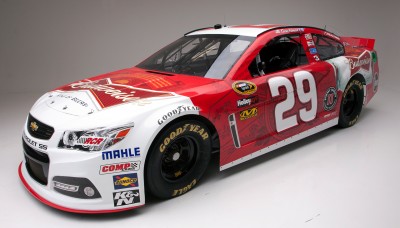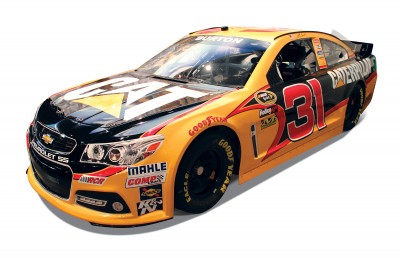On February 16, restyled vehicle wraps hit the road as the National Association for Stock Car Auto Racing’s (NASCAR’s) 2013 Sprint Cup Series kicked off at Daytona National Speedway in Daytona Beach, Fla. All of the car wraps had to be reconfigured due to new regulations.
This year marks the 65th anniversary of NASCAR, which now has more than 75 million fans around the world. As such, racing teams’ sponsors invest heavily to ensure their brands and logos are prominently featured on colourful wraps.
“Sponsorship is the lifeblood of our organization,” says David Hart, director of corporate communication for Richard Childress Racing (RCR), one of the high-profile teams. “With the cost of sponsorship for a NASCAR Sprint Cup Series team now at $20 million or more, getting their big, bold, colourful graphics just right—including colour-matched logos—is essential for promoting the companies that support us.
Almost every team has its own crew of graphics professionals designing, digitally printing and installing the wraps. NASCAR’s new ‘generation six’ auto-body regulations have posed extra challenges for their work this year.
“NASCAR introduced a new set of body-style and tolerance rules, so we needed to create new three-dimensional (3-D) renderings and design templates for all of our wraps,” explains Nick Woodward, RCR’s graphics manager. “The changes were significant, requiring both our graphics crew and our digital printers to work overtime.”
RCR employs a staff of five to wrap cars for such drivers as Jeff Burton, Kevin Harvick and Paul Menard. First, the design and production work takes place at a 232-m2 (2,500-sf) graphics centre at RCR’s campus in Welcome, N.C. Then, after creating and outputting the graphics using Roland DGA printers, the crew performs the actual wrap installations in three of RCR’s on-campus body shops. They wrap not only the racecars, but also the trucks and trailers that transport the cars to and from NASCAR racetracks.
In addition to reconfiguring the car wraps to meet the new regulations, the crew had to redesign existing wraps for returning sponsors and create two new ones for first-time sponsors Shore Lodge and White Tail Resort. They also created a special Honey Nut Cheerios wrap for the car Austin Dillon would use in his attempt to qualify for his first Daytona 500 race.
While RCR’s crew took advantage of the off-season to design and install these wraps, they also need to work during the season to make sure the graphics continue to look good.
 “Under normal city street conditions, these vehicle wraps would be durable and long-lasting, but NASCAR conditions are far from ordinary,” says Woodward. “It’s a world of scratches, bang-ups and full-on crashes. We completely rewrap every one of our cars prior to each race, which means we’re installing wraps on an average of seven to nine vehicles per week.”
“Under normal city street conditions, these vehicle wraps would be durable and long-lasting, but NASCAR conditions are far from ordinary,” says Woodward. “It’s a world of scratches, bang-ups and full-on crashes. We completely rewrap every one of our cars prior to each race, which means we’re installing wraps on an average of seven to nine vehicles per week.”
RCR’s crew relies on four Roland eco-solvent inkjet printers and printer-cutters, including 1.4-m (54-in.) and 1.6-m (64-in.) models. Over the years, such technologies have been part of a shift away from painted graphics.
“Just about every graphics team in NASCAR has turned to digital printing,” says Woodward. “Multiple layers of paint add around 6.4 kg (14 lb) to one of our cars. A wrap adds only 4 (9 lb). A lighter vehicle means more speed. And being able to remove a wrap to make body repairs, instead of having to strip off all the paint and then repaint, is a big advantage. A removable wrap can be peeled off quickly and easily.”
It is also important to use reliable equipment.
“There are periods when we’re running our large-format printers 14 to 16 hours a day, seven days a week,” says Woodward. “These machines are workhorses. We couldn’t get the job done without them.”






